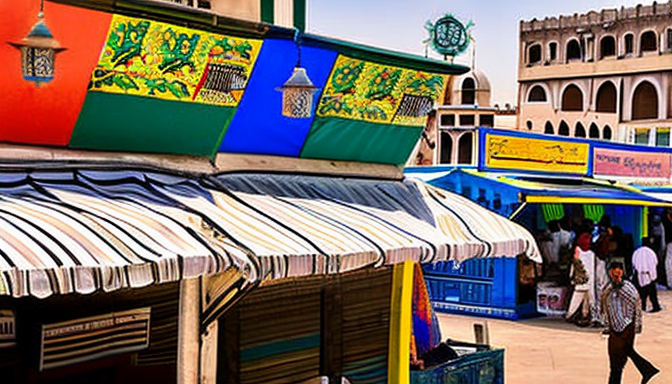Karachi, a bustling metropolis today, was once a canvas for colonial ambitions. The British era left a profound mark on its landscape, shaping not just the buildings but the very essence of the city. Imagine wandering through streets lined with majestic structures, each telling stories of a time when Karachi was a vital port and a cultural melting pot.
During the colonial period, Karachi transformed dramatically. The architecture you see today is a blend of European elegance and local influences. Buildings like the iconic Frere Hall and the majestic KPT Head Office stand as testaments to this fusion. They are not just pretty facades; they reflect the aspirations and policies of the British, aiming to showcase their power and influence.
But why should we care about these old buildings? Well, they are more than just bricks and mortar. They are windows into the past, revealing how colonial policies affected daily life. For instance, the introduction of new urban planning methods changed how Karachi expanded. The city grew, but so did its complexities.
As you stroll through these historic sites, consider how they shaped the identity of Karachi. The colonial legacy is woven into its culture, economy, and demographics. It’s like a tapestry, where every thread tells a story. So, the next time you find yourself in Karachi, take a moment to appreciate these architectural marvels. They are not just buildings; they are the heartbeat of a city that has seen it all.
Architectural Marvels of the Colonial Period
When you stroll through Karachi, you can’t help but notice the **stunning buildings** that tell a story of the past. These architectural marvels are not just pretty facades; they are a glimpse into the city’s colonial history. Imagine walking down a street lined with **elegant structures**, each one whispering tales of British rule. From the **grandiose** to the **quirky**, these buildings showcase a unique blend of European and local styles.
One of the most iconic structures is the **Frere Hall**, completed in 1865. Its Gothic architecture stands tall, surrounded by lush gardens. Did you know that it was originally built as a town hall? Today, it serves as a cultural hub, reminding us of its rich past. Another gem is the **Mohatta Palace**, a stunning pink sandstone structure that once belonged to a wealthy merchant. It’s a beautiful example of **Indo-Saracenic architecture**, blending local traditions with British influences.
These buildings aren’t just for show. They played significant roles in Karachi’s development. The policies implemented during the colonial era shaped the **urban landscape**, making it a melting pot of cultures. As you explore, consider how these structures have stood the test of time, reflecting the city’s **evolving identity**. The colonial architecture of Karachi is a **visual feast** that continues to inspire awe and admiration, making it an essential part of the city’s heritage.

Historical Significance and Cultural Impact
Karachi’s colonial past is like a rich tapestry, woven with threads of history, culture, and architecture. The British era brought significant changes to the city, shaping its identity in ways that still resonate today. Imagine walking through streets lined with majestic buildings, each telling a story of a time when Karachi was a bustling hub of trade and culture.
The policies implemented during British rule had a profound impact on the city’s urban landscape. They introduced a structured approach to city planning, which included the development of roads, parks, and public spaces. This was not just about beautification; it was about creating a modern metropolis. The architecture from this period reflects a unique blend of European styles with local influences, resulting in stunning structures like the Frere Hall and the Empress Market.
Moreover, the colonial era significantly influenced Karachi’s social fabric. It attracted diverse communities, turning the city into a melting pot of cultures. This diversity is still evident in the vibrant neighborhoods, languages spoken, and culinary delights available today. The legacy of this period is not merely in the buildings but in the people and their stories.
As we explore Karachi’s colonial heritage, we uncover layers of history that shaped its economic and cultural landscape. The echoes of the past remind us of a city that has always been dynamic, adapting and evolving while holding onto its rich heritage. Understanding this history is crucial. It helps us appreciate the beautiful chaos that is Karachi today.
Frequently Asked Questions
- What are some key architectural landmarks from Karachi’s colonial era?
Karachi boasts several stunning landmarks like the Frere Hall, the Mohatta Palace, and the Sindh High Court. These buildings showcase a fascinating blend of European and local architectural styles that emerged during British rule, adding a unique charm to the city.
- How did the colonial period influence Karachi’s culture?
The colonial era significantly shaped Karachi’s social fabric, introducing diverse cultural practices and economic activities. This fusion of cultures has left a lasting legacy, influencing everything from cuisine to festivals, making the city a vibrant melting pot.
- Are there guided tours available for exploring these historical sites?
Absolutely! There are various guided tours available that focus on Karachi’s colonial heritage. These tours often include visits to major landmarks and provide insightful commentary on their historical significance, making it a fantastic way to experience the city’s rich past.
- Can I visit these sites on my own?
Yes, many of these historical sites are open to the public, and you can explore them at your own pace. Just make sure to check the visiting hours and any entry requirements ahead of time!